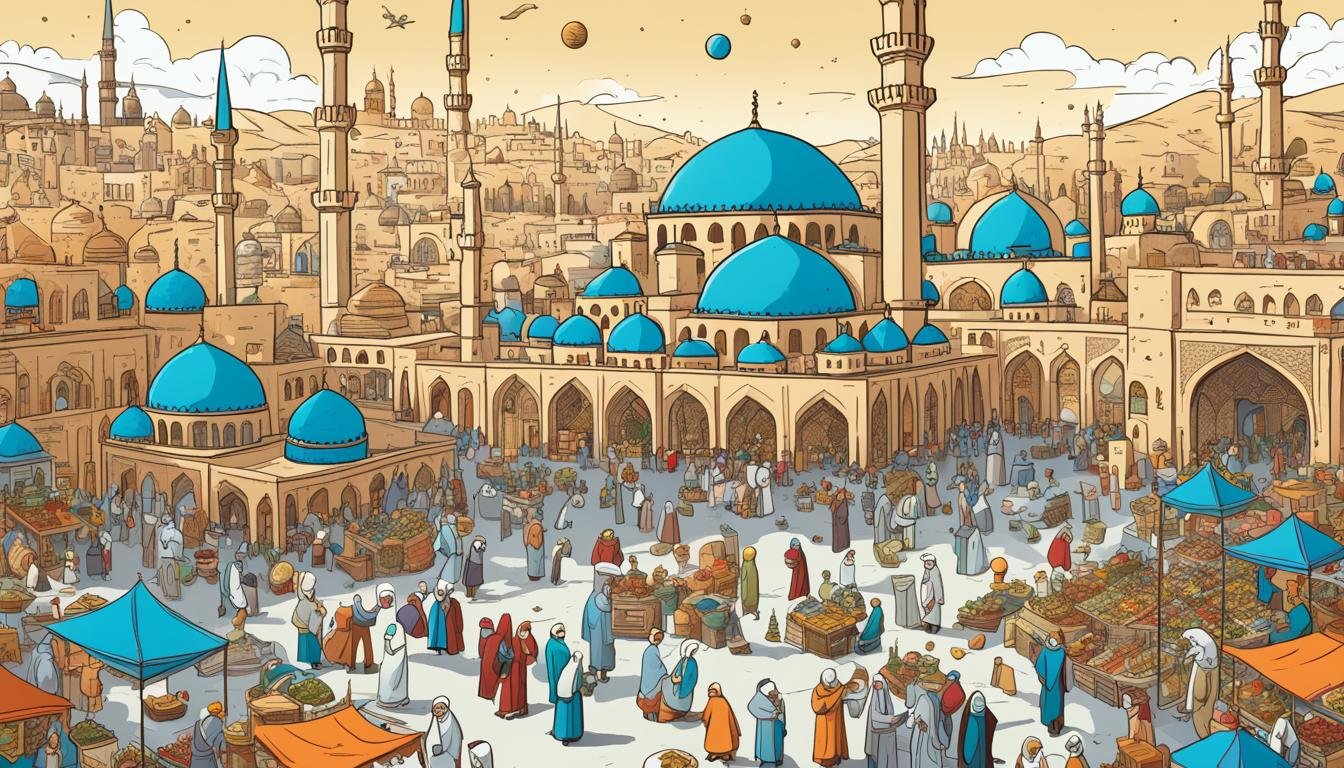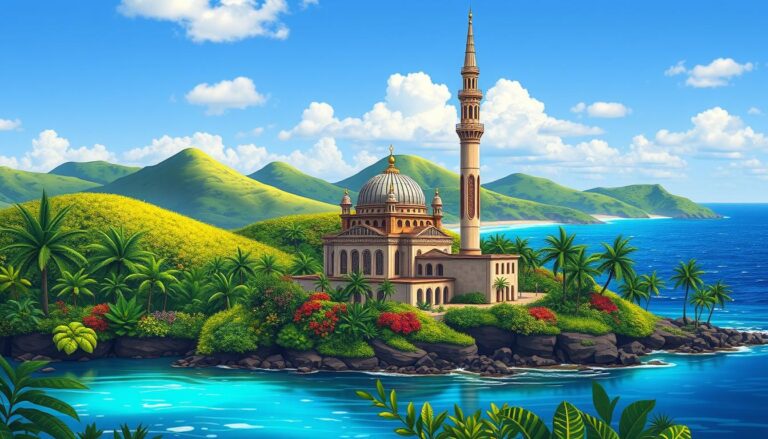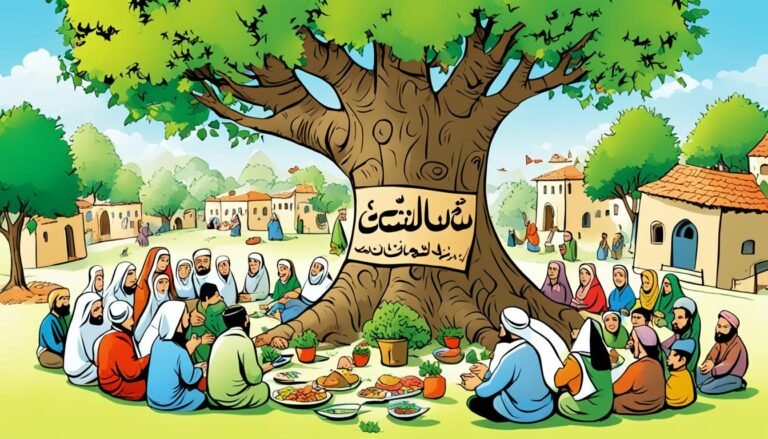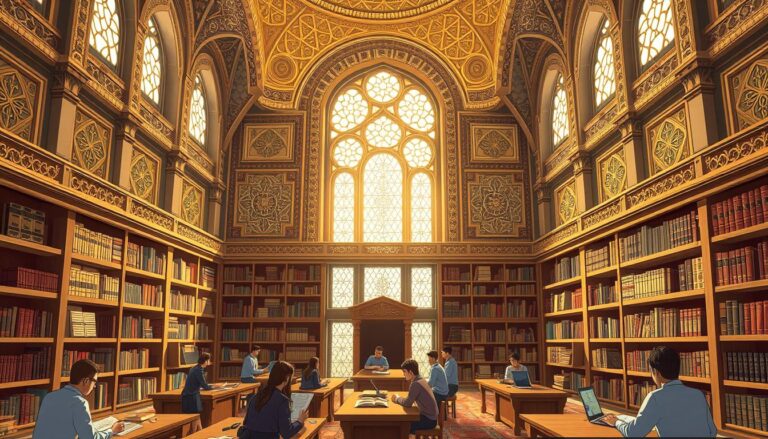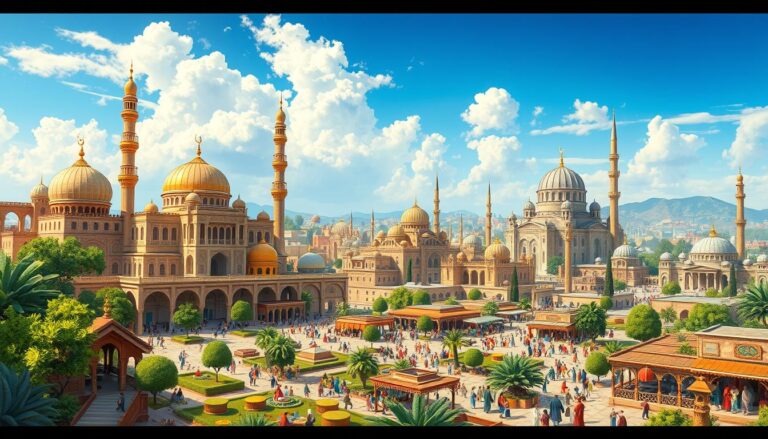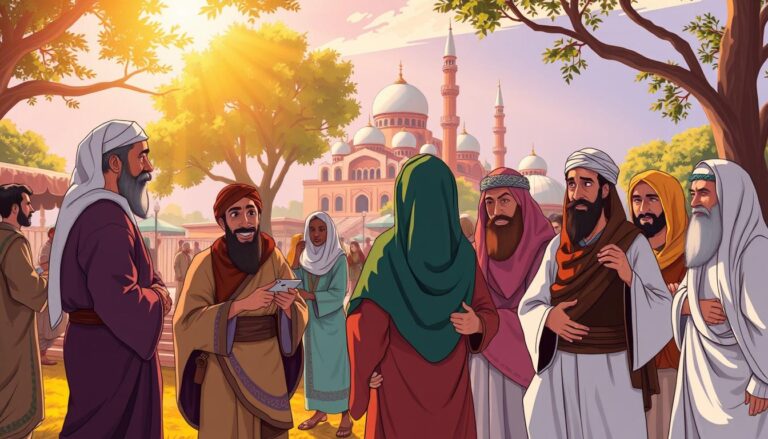Islamic Contributions to Global Culture and Civilization
Have you ever thought about how a civilization from over a thousand years ago still affects our lives today? The Islamic civilization, alive from the 7th century to the early 20th century, set the stage for progress in many areas. These include science, art, architecture, and philosophy. It shaped the Muslim world and even touched Europe and beyond.
During the Golden Age from the 7th to the 15th century, thinkers and innovators made big strides. They lit the way from the Dark Ages to the Renaissance. Their work shows how global cultures are connected. It also broadened our view of knowledge, hygiene, and art.
Let’s look at how Islamic scholars, artists, and thinkers have shaped modern civilization.
Key Takeaways
- The Islamic civilization’s influence spans several domains including science, art, and education.
- The Golden Age of Islam saw remarkable advancements benefitting both the Muslim world and Europe.
- Innovations in hygiene and culinary practices introduced by Muslims have shaped modern living.
- Madrassas played a vital role in education, leading to the foundation of modern universities.
- Islamic art and architecture showcase a blend of beauty and functionality still admired today.
Introduction to Islamic Civilization
The story of Islamic civilization started in the 7th century with Islam’s rise. This marked a big change in culture. It blended many cultures, like Greek, Persian, Indian, and others, creating a world full of knowledge and creativity.
Islam brought a new historical context. It set up a way of life that valued learning, trade, and the arts. From the 7th to the 15th centuries, Islamic civilization shone brightly. This was known as the Golden Age of Islam, where big leaps were made in knowledge, sciences, and arts.
Many dynasties added to Islamic civilization’s cultural wealth. The Umayyad caliphs spread Muslim rule to Spain and India. The Abbasid dynasty was famous for its science and art progress, especially in Baghdad. These efforts set the stage for future ties between the Islamic world and the West.
Today, Islamic civilization’s impact is still seen in many areas, like art, philosophy, and science. The big steps made back then show a lasting impact that touches many parts of the world.
The Golden Age of Islam
The Golden Age of Islam lasted from the 8th to the 13th centuries. It was a time of great growth and intellectual achievements. Scholars from different backgrounds worked together, thanks to a supportive historical context.
Baghdad was a key place for learning, with the House of Wisdom at its heart. Scholars there worked to translate and preserve ancient texts. Cities like Cairo and Córdoba also saw big leaps in many fields, making this era a crucial part of history.
Definition and Historical Context
The Golden Age of Islam began under Abbasid Caliph Harun al-Rashid. It was a time of cultural exchange and deep thinking. Scholars made big contributions, leading to new discoveries.
They didn’t just translate old texts; they built on them. This laid the foundation for future discoveries. For example, the invention of paper made sharing knowledge easier.
Key Contributions During the Golden Age
Many innovations came out during the Golden Age. In mathematics, Muhammad ibn Mūsā al-Khwārizmī started algebra. His work changed the field and introduced the term “algebra.”
Medicine also saw big growth, with the creation of hospitals and medical encyclopedias. These changes affected both Islamic and Western medicine.
Art wasn’t just about science and medicine. Crafts like ceramics, metalwork, and textiles flourished. Calligraphy became a key art form, using complex designs to express spiritual ideas. The Golden Age of Islam shows the impact of scholars and their innovations.
| Field | Notable Contributions | Prominent Scholars |
|---|---|---|
| Mathematics | Development of algebra and algorithms | Al-Khwārizmī |
| Medicine | Establishment of hospitals and medical encyclopedias | Hunayn ibn Ishaq |
| Philosophy | Integration of Greek philosophy into Islamic thought | Ibn Rushd (Averroës) |
| Art | Advancements in ceramics, textiles, and illuminated manuscripts | N/A |
Islamic Science and Medicine
Islamic medicine became a key area of study during the Islamic Golden Age, from the 8th to the 16th centuries. This time was filled with major advances in medicine. Hospitals, pharmacies, and medical education thrived. Famous scholars like Al-Razi and Ibn Sina (Avicenna) wrote important books. These books mixed real-world observations with theory, laying a strong base for future discoveries.
Groundbreaking Developments in Medicine
Islamic medicine made huge leaps, changing health sciences for the better. The Bimaristan, a new type of hospital, offered care to everyone, no matter their social class. It focused on keeping things clean and used the latest in medical care. Books from this time, like Ibn Sina’s The Canon of Medicine, were key in Europe. They listed medical knowledge and were used until the 18th century, showing the deep thinking of Islamic scholars.
- Introduction of hospitals with distinct wards for patients
- Standardization of medical education and practices
- Advanced surgical instruments and techniques
- Innovative pharmacology approaches with the establishment of pharmacies
Influence of Islamic Medicine on Western Practices
Islamic medicine’s ideas reached Western medicine, especially in the Renaissance. Ideas like using quarantine and clinical trials were big steps forward. Surgical methods and clean hospitals set the stage for today’s medicine. Scholars in Islamic medicine also stressed the importance of ethics and professionalism in medicine today.
| Islamic Contributions | Impact on Western Medicine |
|---|---|
| Bimaristan (Hospitals) | Informed structure of modern hospitals |
| The Canon of Medicine | Standard medical text in European universities |
| Surgical Techniques | Basis for modern surgical practices |
| Pharmacy Development | Established practice for drug preparation and distribution |
Islamic Art and Architecture
Islamic art and architecture cover a wide range of cultural expressions. They are shaped by history and religious beliefs. This art spans about 1400 years, showing the rich diversity of Islamic art. From geometric patterns to detailed calligraphy, each piece carries deep spiritual and philosophical meanings.
These works show the base of Islamic civilization. Art was not just for beauty but to show faith and devotion.
Characteristics of Islamic Art
Islamic art stands out with its mix of themes and styles. Some key features are:
- Geometric Patterns: These designs show infinity and Allah’s nature, often in tiles and decorations.
- Calligraphy: This art form is highly valued. It brings the Quran to life and has both beauty and meaning.
- Vegetal Patterns: These floral designs, known as arabesques, highlight beauty and the divine.
- Aniconism: This rule avoids direct human figures in religious art, using abstract designs instead.
- Historical Influences: Islamic art combines styles from Greco-Roman, Byzantine, and Persian traditions, creating something unique.
Famous Architectural Achievements
Islamic architecture is known for its grand structures. These buildings show off engineering skill and beauty. Some top examples are:
- Alhambra: A beautiful site in Spain, it’s famous for its detailed tiles and water features.
- Great Mosque of Samarra: This mosque has one of the biggest minarets and shows the beauty of ancient Islamic architecture.
- Taj Mahal: Known as a symbol of love, this mausoleum is a prime example of Mughal architecture’s detailed designs.
- Dome of the Rock: In Jerusalem, this site mixes Byzantine architecture with Islamic art.
- Great Mosque of Kairouan: Built in 670, it’s one of the earliest and most important examples of early Islamic architecture.
Islamic Literature and Philosophy
Islamic literature and philosophy are rich and deep. They cover centuries of culture and thought. Scholars and poets have left a lasting mark by exploring big ideas. They’ve shaped Islamic culture and influenced literature worldwide.
Prominent Figures in Islamic Literature
In the Islamic Golden Age, many famous writers and poets emerged. They added to the traditions of poetry and stories. Here are some of these important people and their big contributions:
| Figure | Contribution | Notable Works |
|---|---|---|
| Rumi | Poet and mystic; emphasized love and spirituality. | Masnavi, Diwan-e Shams-e Tabrizi |
| Al-Ghazali | Philosopher and theologian; combined Islamic philosophy with mysticism. | Deliverance from Error, The Incoherence of the Philosophers |
| Omar Khayyám | Poet, mathematician, and astronomer; renowned for his quatrains. | Rubáiyát of Omar Khayyám |
| Abu Nuwas | Known for his wine poetry and innovative verse forms. | Diwan |
This period saw the rise of complex poetry forms like the qasida and the ghazel. These works amazed people. The impact of these famous figures is still felt today, as their works are loved in and outside the Islamic world.
The Influence of Islamic Philosophy on the West
Islamic philosophy has greatly influenced Western thought. Scholars like Averroes (Ibn Rushd) were key in sharing ideas from thinkers like Aristotle and Plato. This started in the 8th century and helped bring cultures closer together. The main effects were:
- Introduction of critical thinking methodologies.
- Development of rationalism in European philosophical discourse.
- Influence on the scholastic traditions of medieval universities.
These discussions between Islamic and European scholars helped start the European Renaissance. Islamic philosophy’s impact still shapes our thoughts today. It shows how different cultures and ideas are connected.
Islamic Mathematics and Science
Islamic mathematics shows a deep understanding of numbers, geometry, and the universe. It thrived from the 8th to the 13th centuries CE. Scholars like Muhammad ibn Musa al-Khwarizmi made big contributions. Their work changed science in the Islamic world and beyond.
The Role of Mathematics in Islamic Civilization
Islamic mathematics introduced Hindu-Arabic numerals and the zero. Al-Khwarizmi wrote important books that spread these numbers and decimal placement. His book, “Kitab al-jabr wa’l-muqabalah,” showed how to apply these numbers in real life, like in Islamic inheritance laws.
Big achievements during this time were:
- The invention of algebra in Baghdad.
- Using geometry in art.
- Solving quadratic equations with “completing the square.”
Later, Omar Khayyam built on these ideas. He solved hard equations and set the stage for algebra by the 14th century.
Contributions to Astronomy and Geography
Mathematics was key in Islamic astronomy and geography. Scholars made advanced astronomical tables and used the astrolabe for better star observations. Al-Battani and Ibn al-Haytham greatly improved our understanding of planets and light.
Geography got better with:
- Ibn Battuta’s travel stories.
- Using Indian arithmetic and zero in maps.
- Thābit ibn Qurrah’s translations of Greek math, paving the way for astronomy.
This mix of math, astronomy, and geography gave Islamic civilization a strong scientific base.
| Mathematician | Key Contributions | Period |
|---|---|---|
| Muhammad ibn Musa al-Khwarizmi | Popularized Hindu-Arabic numbers and introduced algebra | 800-847 CE |
| Omar Khayyam | Solved general problems of extracting roots | 11th century |
| Al-Battani | Advanced understanding of astronomy and planetary movements | 9th century |
| Ibn al-Haytham | Developed techniques in optics | 10th century |
| Ibn Battuta | Travel accounts that enhanced geographical knowledge | 14th century |
Islamic Education Systems
Islamic education has deep roots in history, shaping the minds of Muslim societies. Madrassas emerged as key learning centers. They offered a wide curriculum that included theology, science, and the arts. This framework greatly influenced education in Europe.
The Emergence of Madrassas
Madrassas grew in Islamic civilization, appearing in many regions. By the 11th century, they became centers of learning shaped by religious interests. Cities like Baghdad and Cairo became centers of learning, with hundreds of madrassas.
The Niẓāmīyah madrasa in Baghdad, founded in 1057, shows their importance. These institutions catered to various educational needs.
The Role of Al-Qarawiyyin University
Al-Qarawiyyin University in Fez, Morocco, started in 859 AD. It’s the oldest continuously operating university in the world. This university was a hub for learning, attracting scholars and students.
It made significant contributions to fields like mathematics, astronomy, and philosophy. Al-Qarawiyyin’s impact wasn’t just in the Islamic world but also in Europe, showing the wide reach of Islamic education.
| Key Features | Madrassas | Al-Qarawiyyin University |
|---|---|---|
| Founded | Various dates, peak in the 11th century | 859 AD |
| Location | Baghdad, Cairo, and other cities | Fez, Morocco |
| Focus Areas | Theology, Science, Arts | Mathematics, Astronomy, Philosophy |
| Impact | Foundation for European universities | Influenced both Islamic and European education |
| Legacy | Centuries of intellectual discourse | Oldest degree-granting university |
Islamic Calligraphy
Islamic calligraphy is more than just a visual art. It’s a blend of spirituality and expression. This art form showcases the beauty of Arabic script. Master calligraphers use styles like Thuluth, Naskh, and Diwani to create beautiful texts.
These techniques help make religious texts, poetry, and architectural inscriptions. They are a big part of the Islamic world’s beauty.
Forms and Techniques of Calligraphy
Great calligraphers from Baghdad started it all. Ibn Muqla and Yakut al-Musta’simi created a theory of proportion. Their work changed calligraphy from the kufic script to more flowing styles by the 900s.
This led to the development of scripts like the sulus script. It’s known as the “mother of calligraphy.” Different scripts were used for different sizes and looks.
The Cultural Significance of Calligraphy
Islamic calligraphy means more than just art. It connects communication and artistic expression deeply in Islamic culture. It tells spiritual stories and helps people feel connected and devoted.
This art has always been linked to learning. Its impact is still felt today, inspiring new generations.
Source Links
- Contributions of Islamic Civilization to the Modern World
- Muslim Contributions to Civilization – ING
- Courses – Islamic Civilization and Societies
- Expansion of Islamic Civilization
- The Islamic Golden Age | World Civilization
- Islamic Golden Age
- The Air of History Part III: The Golden Age in Arab Islamic Medicine An Introduction
- Important Islamic Contributions to Medicine
- The contribution of Islamic culture to the Development of Medical Sciences | Journal of the British Islamic Medical Association
- The Nature of Islamic Art | Essay | The Metropolitan Museum of Art | Heilbrunn Timeline of Art History
- Early Islamic Art and Architecture
- Islamic art
- A Flourishing Era of Science and Culture
- Islamic literature
- Islamic Civilization: Features, Achievements, and Challenges
- Islamic Mathematics
- Mathematics – Islamic World, 8th-15th Century
- Education – Muslim, Aims, Purposes
- Exploring Islamic Culture: Its Roots and Global Influence
- The History of Islamic Calligraphy – Education – Asian Art Museum
- Everything to know about Islamic Architecture and Its Global Influence

